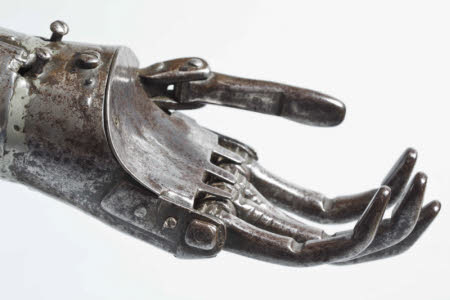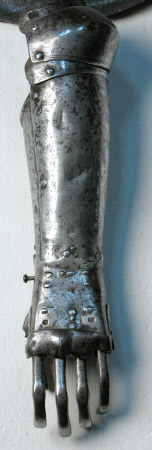Mechanical arm
Category
Arms and armour
Date
circa 1550 - circa 1650
Materials
Measurements
420 mm (Length)
Place of origin
Europe
Order this imageCollection
Cotehele, Cornwall
NT 347324
Caption
This prosthetic arm is a remarkable invention and a survival from a brutal period. Terrible injuries were inflicted on the battlefields of Europe in the 16th and 17th centuries, from arrow and gunshot wounds to the loss of limbs. This led surgeons such as Ambroise Paré (1510–90) to work with armourers to design and produce pioneering prostheses, including mechanically functioning hands and arms. The existing artificial substitutes for amputated limbs, such as wooden pegs, were often stiff and clumsy. Paré wanted them to be more functional, simulating the natural movement of the limb. This ingenious example has moveable fingers that can be individually locked into place with tiny buttons, allowing a soldier to grip his reins or sword, and giving the wearer some flexibility. It weighs almost 1.3kg and is displayed in the Great Hall among examples of weapons and armour. It is known to have been at the property since at least the 1830s.
Summary
Mechanical arm for left hand, fingers lock into place by a stud to enable grip on reins or weapon. It weighs 1.274 Kilos (2lb 13oz). Three buttons can lock the five cast fingers into place. One button on the side of the wrist controls the thumb, another on the underside of the wrist locks or loosens index and middle finger whilst the third, next to the second, is there for ring finger and little finger. Each finger can be put into another position, ratchets and studs keep them in place.
Full description
Felix Fischborn, placement student at Cotehele in 2008, researched this item: “Throughout the 16th and 17th centuries Europe was torn by wars. Gunshots and arrow wounds, fractures and dislocations, burns and gashes were treated by the surgeons accompanying the military campaigns. Medical services were not centrally organised, but in England the Royal Sergeant Surgeon could urge surgeons to serve with the monarch’s forces for the duration of a campaign. Some surgeons who published books or treatises on their profession had gathered their information on the battlefields of their times. Among them are Ambroise Paré who published Dix livres de la chirurgie in 1564 and John Woodall and his The surgeons mate of 1617. Ambroise Paré was a surgeon under François I serving the generals in command of infantry of the French army. Besides describing new methods of treatment and revolutionary operation techniques, he depicted mechanical hands, too. The prints shown are taken from his books and from an English translation published in 1634. They show that some of these prostheses were rather simple whilst others were highly mechanized devices, enabling otherwise lost functions of the limb. In the 16th century prostheses were usually made by armourers. Some were made in collaboration with locksmiths or clockmakers. Though artificial limbs have been made since antiquity – Pliny the Elder (AD 23 or 24 to AD 79) mentions a Roman nobleman who fought in the Second Punic War (218 to 201 BC) with an iron hand and an Egyptian mummy with a prosthetic foot was found, too – this artificial hand is a rare survivor. As with many objects at Cotehele, we do not know how it came here. First evidence of the hand at Cotehele is given in the lithographic print made after a watercolour painted in the 1830s by Nicholas Condy. This print is on display in the Breakfast Room, and it shows the hand hanging on the North wall of the Hall, similar to its current position.” A replica was made by Context Engineering, Powys, in 2009 (348927). Cotehele’s mechanical hand features in ‘Mechatronic Hands: Prosthetic and Robotic Design’ by Paul H. Chappell, published by the Institution of Engineering and Technology (2016). ISBN 978-1785611544.




